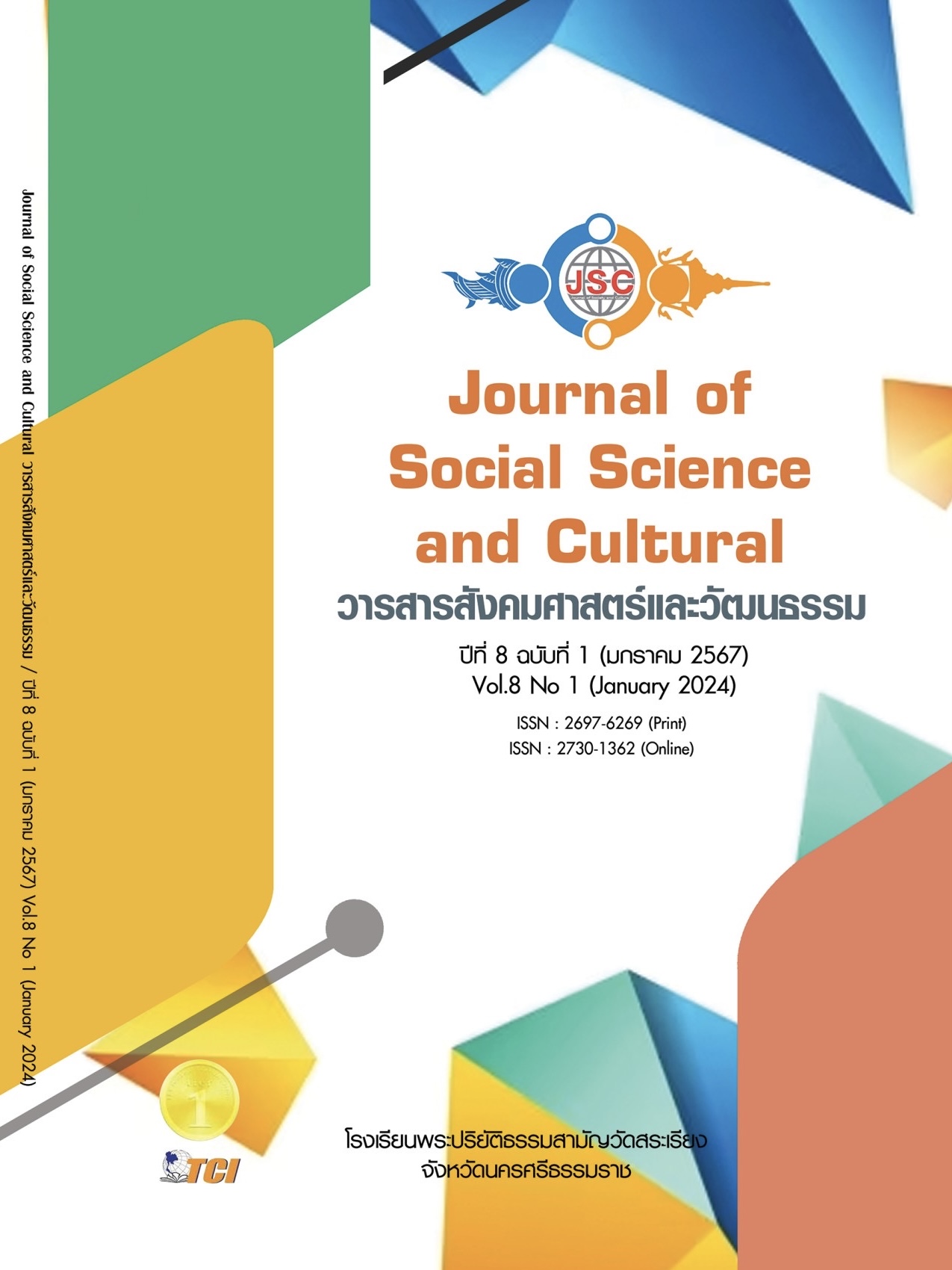DESIGNING SOUVENIR PRODUCTS TO PROMOTE THE MUSEUM AS A NEW CENTER OF TOURISM: A CASE STUDY OF WAT PHRA RUP MUSEUM, SUPHANBURI PROVINCE
Main Article Content
Abstract
This article is part of an activity—namely, ‘designing community product merchandise to promote community product merchandise’ —which, in turn, is part of a research project titled ‘Developing Wat Phra Rup Temple into a Center of Learning and Creative Economy.’ In this activity, the author applies the knowledge gained from previous projects conducted during the 1st and 2nd years to the designing process. The objective is to synthesize knowledge from research and apply it to designing patterns on souvenir products to promote tourism at Wat Phra Rup Museum. The designing concepts learned from previous projects are applied to the creation of souvenir products. The selection of the patterns using a focus group method discussion between four related parties: the authors, the abbot, the board of directors of Wat Phra Rup Temple, and 10 community representatives through purposive sampling. These parties jointly concluded that the patterns must represent unique characteristics of Wat Phra Rup Temple to make their souvenirs more distinctive. The patterns include a masterpiece of antiques displayed in Wat Phra Rup Museum—the Wooden Buddha’s Footprint made with the Lai Phra Tan Vajrasana (Enlightenment Throne of the Buddha) pattern, symbolizing the moment of Enlightenment when Gautama Buddha became enlightened. Another selected pattern is Lai Phra Mae Thorani Beep Muai Pom (Mother Earth Goddess Wringing Waters out of her hair), Images of various animals are also used in the designs to complement the main vistas, the history of Buddha during the episode of his encounter with, and triumphant of, the devils, such as the images of elephant, horse bird, and turtle. The prototype souvenirs that will be sold in Wat Phra Rup Museum can be divided into 3 types: cloth bag, keychain, and paper cup sleeves. Regarding the author’s effort to impart souvenir designs and knowledge to the temple and the local community, the results indicated satisfaction among the people. They recognized the practical use of these products and realized that these souvenir products could help promote Wat Phra Rup Museum as a New Center of Tourism in Suphanburi Province.
Article Details
References
จุรีวรรณ จันพลา และคณะ. (2559). การพัฒนารูปแบบผลิตภัณฑ์ผ้าทอไทยทรงดำเพื่อสร้างมูลค่าเพิ่มตามแนวทาง เศรษฐกิจสร้างสรรค์. วารสาร Veridian E–Journal ฉบับภาษาไทย สาขามนุษยศาสตร์ สังคมศาสตร์ และศิลปะ, 9(2), 82-98.
ปานฉัตท์ อินทร์คง. (2556). การพัฒนาผลิตภัณฑ์ที่ระลึกชนเผ่าภาคเหนือเพื่อส่งเสริมการท่องเที่ยวเชิงเศรษฐกิจสร้างสรรค์: กรณีศึกษาชนเผ่าม้งและเย้า. เชียงราย: สำนักงานคณะกรรมการวิจัยแห่งชาติ.
พนัชกร สิมะขจรบุญ และเอกรินทร์ จินดา. (2561). การออกแบบผลิตภัณฑ์และบรรจุภัณฑ์ขนมหวานพื้นถิ่นของชุมชนเทศบาลตำบลบางตะบูน จังหวัดเพชรบุรี เพื่อพัฒนาให้เป็นสินค้าการท่องเที่ยว. วารสาร Veridian E–Journal ฉบับภาษาไทย สาขามนุษยศาสตร์ สังคมศาสตร์และศิลปะ, 11(1), 3,634-3,625.
วัฒนะ จูฑะวิภาต. (2545). ศิลปะพื้นบ้าน. กรุงเทพมหานคร: สิปประภา.
ศุภชัย ชาญวรรณกุล และเทิดชาย ช่วยบํารุง. (2562). การจัดการการสื่อความหมายของศิลปะไทยในสนามบินสุวรรณภูมิ. วารสารวิชาการนวัตกรรมสื่อสารสังคม, 7(1), 25-34.
สิโรตม์ ภินันท์รัชต์ธร และคณะ. (2564). การวิจัยและพัฒนาเพื่อยกระดับพิพิธภัณฑ์วัดพระรูป จังหวัดสุพรรณบุรีให้เป็นแหล่งเรียนรู้ตลอดชีวิตที่เหมาะสมกับสังคมไทยในศตวรรษที่ 21(ปีที่ 1). กรุงเทพมหานคร: สำนักงานสภานโยบายการอุดมศึกษา วิทยาศาสตร์ วิจัยและนวัตกรรมแห่งชาติ (สอวช).
สิโรตม์ ภินันท์รัชต์ธร และคณะ. (2565). การวิจัยและพัฒนาเพื่อยกระดับพิพิธภัณฑ์วัดพระรูป จังหวัดสุพรรณบุรี ให้เป็นแหล่งเรียนรู้ตลอดชีวิตที่เหมาะสมกับสังคมไทยในศตวรรษที่ 21 (ปีที่ 2). กรุงเทพมหานคร: สำนักงานสภานโยบายการอุดมศึกษา วิทยาศาสตร์ วิจัยและนวัตกรรมแห่งชาติ (สอวช).
สุชาติ อิ่มสำราญ และคณะ. (2564). การออกแบบผลิตภัณฑ์ของที่ระลึกจากอัตลักษณ์ศิลปะพื้นบ้านสำหรับนักท่องเที่ยว. วารสารวิชาการคณะสถาปัตยกรรมศาสตร์ สจล., 33(2), 115-129.
Mikell, P. G. (2000). Automation, Production Systems, and Computer-Integrated Manufacturing. (2nd ed.). New Jersey, U.S.: Prentice Hall.
Phriwanrat, K. (2020). The Research and Development of Tie-dyed Handicraft Products from Krabi Province for the Designing of Ko Klang Community’s Contemporary Souvenirs, Leading Krabi Province to Creative City. Humanities, Arts and Social Sciences Studies (HASSS), 20(1), 119-137.


